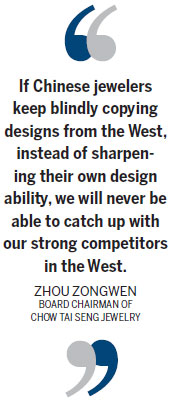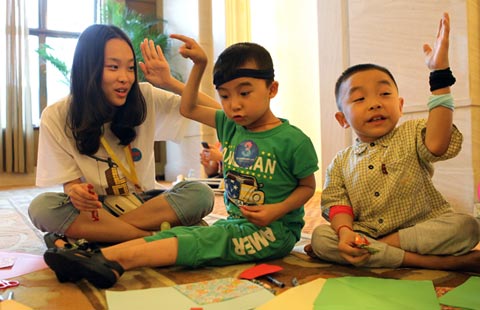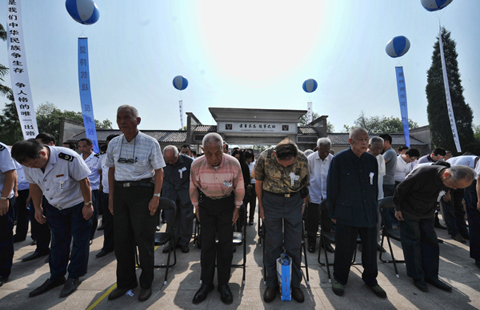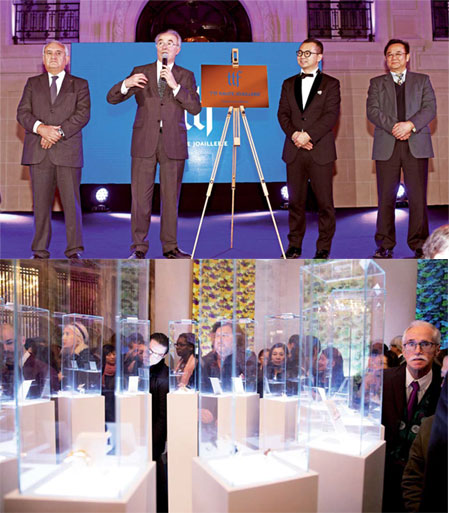Chinese jewelry firms design brighter future
Updated: 2014-09-12 07:44
By Liu Lu(China Daily Europe)
|
|||||||||||
Increasing innovation and brand-building key to challenging Western jewelers' dominance
An increasing number of Chinese jewelry designers are starting to challenge the dominance of top Western luxury jewelry brands, which have continued to briskly open stores in China in the past few years.
From the Western-Chinese fusion style of Bao Bao Wan to more traditional Chinese brands like Chow Tai Fook, Chinese luxury jewelry has increasingly developed a culture-infused style adapting iconic Chinese images, giving it a distinctiveness than has drawn attention from around the world.
"China is booming and so is its high street. Chinese jewelry designers are vying for a place in China's evolving fashion landscape," says Shi Hongyue, vice-secretary general of the Gems and Jewelry Trade Association of China.
"Although most of China's wealthy elite still put a premium on famous imported brands, Chinese jewelry designers appear to be working hard to get this demography more interested in homegrown design."
Retail spending on jewelry in the country reached 470 billion yuan ($76.6 billion, 59.5 billion euros) in 2013, an increase of 107 percent over two years earlier, according to trade association figures.
Shi says Chinese consumers' appetite for jewelry will continue to grow, fueled by their growing wealth, adding that he expects jewelry to become one of the most sought-after possessions after real estate and automobiles for the growing middle class.
"The rising purchasing power of Chinese consumers will provide the fundamentals for rapid market growth, and China is very likely to replace the United States to become the world's largest consumer market for jewelry by 2020," Shi predicts, adding that jewelry consumption in the country has maintained a double-digit annual growth rate in recent years.
Chinese jewelers are investing heavily in branding their own independently designed products through distinctive, trend-setting styles and marketing, aspiring to make the country the birthplace of world-famous jewelry brands.
"With the brisk growth of the country's jewelry market, China's jewelry industry is facing unprecedented development opportunities and its prospects are rosy," says Fu Yonghe, director of the jewelry design department of the Beijing Institute of Fashion Technology, China's first jewelry design school.
"It is the right time for Chinese jewelers to follow the trends to cultivate their own famous jewelry brands."
Fu says China has become the world's largest jewelry processing country by making pieces for many well-known international, so the level of craftsmanship in China is globally recognized. However, there still are few world-class Chinese luxury jewelry brands. That is not only because many local brands lack independent research and development capabilities, Fu says, but also, and most importantly, it's caused by a gap in brand-building awareness that is a hallmark of their Western peers.
"Chinese jewelry is cheaper than international big names, but a price war is not a sustainable strategy. Enhancing design innovation capabilities and strengthening brand-building efforts are vital for Chinese jewelers to gain a stronger foothold in an increasingly intense market," Fu says.
Some Chinese jewelers have become pioneers in brand-building campaigns and have boldly moved into foreign markets. One of the most successful is Wu Fenghua, a jeweler from Shenzhen, who launched his internationally recognized jewelry brand TTF Haute Joaillerie in 2002.
Wu says he is committed to the production of collectible fine jewelry. His clients include famous French filmmaker and screenwriter Anne Fontaine and Chinese actress Qin Lan. Many TTF designs are famed for bringing a fresh perspective to jewelry though a fusion of Eastern and Western aesthetics.
Since 2010, TTF has taken part in the Baselworld Watch and Jewelry Show in Switzerland, the world's biggest trade expo for the items, making it the first Chinese jeweler and the third jeweler from Asia to win a permanent spot at the exhibition.
In March, TTF was the only cultural and creative enterprise to accompany Chinese President Xi Jinping on his state visit to France. There, it signed investment agreements with the Paris Commercial Economic Development Board relating mainly to its opening of new stores in Paris.
TTF recently moved its company headquarters to Place de Vendome, occupied by luxury hotels and many of the world's top jewelry brands. Its Paris flagship store is set to open early next year. It also plans to open stores in London, New York and Hong Kong.
Wu says most Chinese jewelry brands are weak in design innovation, which undermines their competitiveness and limits their sustainable development.
"Some Westerners think that Chinese jewelry makers are only good at making replicas of famous brands," Wu says. "But I want to change their minds by creating a high-end jewelry brand that combines modern design, handcraft and Chinese culture.
"Only the emergence of more original jewelry designs from China can help jewelers from the country have a bigger say in the high-end jewelry market."
British jewelry designer Theo Fennell's work provides a clue of what innovative East-West fusion means. His Chinese Secret Garden ring, one of his most classic designs, which sells for about 40,000 pounds ($64,400), is typical of his fusion designs. Tiny-hinged doors on the ring open to reveal a miniature traditional Chinese garden painted in enamel.
Wu believes the greatest appeal of a jewelry brand lies not only in its design originality and creativity, but also in its rich cultural connotations.
"Our designs are inspired by China's 5,000-year culture and history. TTF absorbs nutrients from Chinese traditional jewelry series imprinted with strong and distinctive Oriental favor, such as the qipao series, Chinese zodiac animal series and jade lotus series."
The qipao series is named after a traditional dress for Chinese women popular during the first decades of the 20th century, and also features pieces evocative of the Art Deco styles of the era often seen in cities like Shanghai.
"Our works provide international buyers with something fresh that can both express Chinese culture and is in line with the trend of international jewelry designs."
Wu says in addition to stiff competition from prominent jewelry makers, the hardest thing is to gain recognition in a market long dominated by Western brands.
"Western elite society did not accept a high-end jewelry brand from China in the first place and doubted our design originality," Wu says. "But we gradually changed their prejudices with our fine products."
Wu says China's homegrown jewelry designers have made huge progress in recent years, particularly young designers who have demonstrated very high standards in innovation and craftsmanship.
"We need the efforts of a new generation of Chinese designers to give Chinese jewelry brands the same brand awareness in the global market as their top European or US counterparts."
With more foreign jewelry brands eyeing China, more forward-looking Chinese jewelry makers have accelerated their brand-building, realizing that competition in the future will be a contest of brand promotion.

Zhou Zongwen, board chairman of Chow Tai Seng Jewelry, says his company has invested heavily in promoting brand awareness over the past few years. He says the cultivation of a world-class Chinese jewelry brand needs time and patience.
Chow Tai Seng, one of China's most popular homegrown brands, has opened 2,300 stores, mostly in medium and high-end department stores, in 32 provinces and autonomous regions across China.
The taste of Chinese consumers is becoming more sophisticated, and more of them favor brands that have a history, which is seen as a guarantee of quality, Zhou says.
"Brand-building is not an overnight thing. Some centuries-old European jewelry brands have advanced brand marketing, positioning, promotion and packaging knowledge, which are well worth learning for Chinese jewelers.
"China is a latecomer in building its own jewelry brands. A lot of famous Western brands have hundreds years of history, but the oldest Chinese (mainland) jewelry brands are only about 20 years old, so we have a lot to do to catch up with our foreign competitors.
"If Chinese jewelers keep blindly copying designs from the West, instead of sharpening their own design ability, we will never be able to catch up with our strong competitors in the West."
To bolster design innovation, Chow Tai Seng has teamed up with famous jewelry designers from Italy and other countries who have helped it produce a series of trendy and stylish fine jewelry. The company has also sent some talented young designers to Europe for training each year.
Last year, it organized a major jewelry design contest, attracting young designers from many countries. Promotional efforts including advertising the competition on one of the famous big screens at New York City's Times Square.
"In the past we have made jewelry rather than created it. Now the development of China's design talent has caught up with the pace of China's jewelry industry, which are both in a stage of rapid development," Zhou says.
Despite difficulties, some jewelry makers are optimistic about the prospects of China's jewelry industry and believe it will not be long until the emergence of the equivalent of top Western jewelry brands in China.
"Chinese are slowly creating some high-end brands. In fact, there are already some Chinese apparel brands that have successfully been built into high-end brands, gradually splitting the market share of international brands," says Cai Guocheng, managing director of KET jewelry, a Hong Kong based company specialized in making gold jewelry.
"There is no longer a shortage of skills at Chinese jewelry enterprises, so I think it won't be long before we see the rise of a high-end jewelry brand from China."
liulu@chinadaily.com.cn
|
Top: From left, Jean-Pierre Raffarin, former French prime minister; Christian Sautter, deputy mayor of Paris; Wu Fenghua, president of TTF; and Xia Yang, deputy head of Futian district, Shenzhen, in attendance of the opening ceremony of jeweler's headquarters in Paris. Above: Visitors at a TTF jewelry show in Paris. Photos Provided to China Daily |
(China Daily European Weekly 09/12/2014 page14)
Today's Top News
Obama orders airstrikes in Syria for first time
Putin blames West for Ukraine crisis
Cameron ' would be heartbroken' if Scotland leaves Union
China restricts overseas TV
Nation capable of hitting growth targets, Li says
Chinese peacekeepers to support South Sudan
Russia lays responsibility for MH17 crash
Space station eyes cooperation with other countries
Hot Topics
Lunar probe , China growth forecasts, Emission rules get tougher, China seen through 'colored lens', International board,
Editor's Picks

|

|

|

|

|

|






